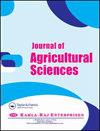An Evaluation of the Performance of Forced Air Cooling on Cooling Parameters in Transient Heat Transfer at Different Layers of Pomegranate
IF 0.7
Q3 AGRICULTURE, MULTIDISCIPLINARY
引用次数: 0
Abstract
The quality of horticultural products can be promoted using high techniques. One of these methods is precooling applied before storage and leads to increased shelf and storage life of the fruit. For this reason, the effect of forced air cooling was conducted to investigate the cooling rate at the center (aril), spongy tissue (peel) and leathery skin (rind) of pomegranate (Punica granatum L.). Airflow velocity as an effective factor in cooling products at three levels of 0.5, 1, and 1.3 m s-1 and temperature of 7.2 °C was considered. Cooling parameters including lag factor and cooling coefficient were calculated from experimental data. Then, half-cooling time and seven-eighths cooling time were obtained at different layers of pomegranate. Cooling heterogeneity was analyzed at different air velocity and at different layers of pomegranate. The results showed that increase in air velocity from 0.5 to 1.3 m s-1, reduced the half-cooling time and seven-eighths cooling time. After 5000 seconds, the change of air velocity had a slight influence on decreasing temperature of different layers of pomegranate. Cooling heterogeneity at the air velocity of 0.5 m s-1 was low and then increased at the air velocity of 1 m s-1. Finally, at the air velocity of 1.3 m s-1, it was declined. The overall results illustrate that the applied methodology in this research, which explains unsteady heat transfer in the cooling process, can be performed in pomegranate or similarly shaped fruits.强制空气冷却对石榴不同层间瞬态换热冷却参数的影响
利用高新技术可以提高园艺产品的质量。其中一种方法是在储存前进行预冷,从而增加水果的货架和储存寿命。为此,对石榴(Punica granatum L.)中部(假种皮)、海绵状组织(果皮)和革质皮(皮)的冷却速率进行了研究。在0.5、1和1.3 m s-1三个水平和7.2°C温度下,风速是冷却产品的有效因素。根据实验数据计算出滞后系数和冷却系数等冷却参数。然后,得到石榴不同层数的半冷却时间和八分之七冷却时间。分析了石榴在不同风速和不同层数下的冷却不均一性。结果表明,风速由0.5 m s-1增加到1.3 m s-1,可缩短半冷却时间和7 / 8冷却时间。5000秒后,风速的变化对石榴各层的降温影响不大。冷却非均匀性在0.5 m s-1风速下较低,在1 m s-1风速下增大。最后,在风速为1.3 m s-1时,它有所下降。总体结果表明,本研究中解释冷却过程中不稳定传热的应用方法可以在石榴或类似形状的水果中执行。
本文章由计算机程序翻译,如有差异,请以英文原文为准。
求助全文
约1分钟内获得全文
求助全文
来源期刊

Journal of Agricultural Sciences
AGRICULTURE, MULTIDISCIPLINARY-
CiteScore
1.80
自引率
0.00%
发文量
0
 求助内容:
求助内容: 应助结果提醒方式:
应助结果提醒方式:


